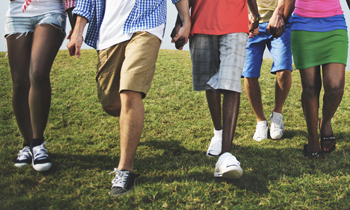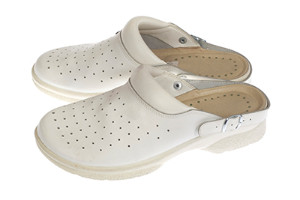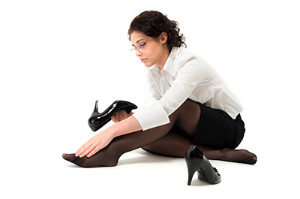Items filtered by date: February 2019
Children and Sever’s Disease
 Sever’s disease is a condition that only affects children because their growth plate is still in the process of maturing. A majority of the children affected by Sever’s disease participate in sports and are between the ages of 10 and 15. This condition causes inflammation around the growth plate of the heel bone, which is still growing. The extra stress placed on the foot during sports activities is usually what triggers Sever’s disease. Pain becomes present in the back of the heel, which becomes more sensitive when pressure is applied during actions like running or jumping. Children might develop a minor limp, and they will usually complain of painful sensations in the heel area. If you think your child might have Sever’s disease, it is recommended you bring them to a podiatrist to learn more about the condition and how it can be treated.
Sever’s disease is a condition that only affects children because their growth plate is still in the process of maturing. A majority of the children affected by Sever’s disease participate in sports and are between the ages of 10 and 15. This condition causes inflammation around the growth plate of the heel bone, which is still growing. The extra stress placed on the foot during sports activities is usually what triggers Sever’s disease. Pain becomes present in the back of the heel, which becomes more sensitive when pressure is applied during actions like running or jumping. Children might develop a minor limp, and they will usually complain of painful sensations in the heel area. If you think your child might have Sever’s disease, it is recommended you bring them to a podiatrist to learn more about the condition and how it can be treated.
Sever's disease often occurs in children and teens. If your child is experiencing foot or ankle pain, see one of our podiatrists from Toe-tal Family Footcare Associates. Our doctors can treat your child’s foot and ankle needs.
Sever’s Disease
Sever’s disease is also known as calcaneal apophysitis, which is a medical condition that causes heel pain I none or both feet. The disease is known to affect children between the ages of 8 and 14.
Sever’s disease occurs when part of the child’s heel known as the growth plate (calcaneal epiphysis) is attached to the Achilles tendon. This area can suffer injury when the muscles and tendons of the growing foot do not keep pace with bone growth. Therefore, the constant pain which one experiences at the back of the heel will make the child unable to put any weight on the heel. The child is then forced to walk on their toes.
Symptoms
Acute pain – Pain associated with Sever’s disease is usually felt in the heel when the child engages in physical activity such as walking, jumping and or running.
Highly active – Children who are very active are among the most susceptible in experiencing Sever’s disease, because of the stress and tension placed on their feet.
If you have any questions, please feel free to contact our office located in Vista, CA and Las Vegas, NV . We offer the newest diagnostic and treatment technologies for all your foot and ankle injuries.
Symptoms of Hammertoe
 It is relatively simple to detect the condition that is known as hammertoe. The middle toes are bent in a downward position, which may often be the result of wearing shoes that are too tight. This type of shoe may not provide adequate room for the toes to move freely in. Additionally, this may create an imbalance in the muscles of the toes and may cause difficulty in straightening the toe. The symptoms that are associated with hammertoe may include pain and discomfort, corns or calluses, or difficulty in walking. Treatment may include using appropriate cushioning on the affected toe or toes, and treating any corns or calluses that may be present. If you feel you have hammertoe, it is advised to consult with a podiatrist who can perform a proper diagnosis, followed by beginning the treatment that is right for you.
It is relatively simple to detect the condition that is known as hammertoe. The middle toes are bent in a downward position, which may often be the result of wearing shoes that are too tight. This type of shoe may not provide adequate room for the toes to move freely in. Additionally, this may create an imbalance in the muscles of the toes and may cause difficulty in straightening the toe. The symptoms that are associated with hammertoe may include pain and discomfort, corns or calluses, or difficulty in walking. Treatment may include using appropriate cushioning on the affected toe or toes, and treating any corns or calluses that may be present. If you feel you have hammertoe, it is advised to consult with a podiatrist who can perform a proper diagnosis, followed by beginning the treatment that is right for you.
Hammertoes can be a painful condition to live with. For more information, contact one of our podiatrists of Toe-tal Family Footcare Associates. Our doctors will answer any of your foot- and ankle-related questions.
Hammertoe
Hammertoe is a foot deformity that occurs due to an imbalance in the muscles, tendons, or ligaments that normally hold the toe straight. It can be caused by the type of shoes you wear, your foot structure, trauma, and certain disease processes.
Symptoms
- Painful and/or difficult toe movement
- Swelling
- Joint stiffness
- Calluses/Corns
- Physical deformity
Risk Factors
- Age – The risk of hammertoe increases with age
- Sex – Women are more likely to have hammertoe compared to men
- Toe Length – You are more likely to develop hammertoe if your second toe is longer than your big toe
- Certain Diseases – Arthritis and diabetes may make you more likely to develop hammertoe
Treatment
If you have hammertoe, you should change into a more comfortable shoe that provides enough room for your toes. Exercises such as picking up marbles may strengthen and stretch your toe muscles. Nevertheless, it is important to seek assistance from a podiatrist in order to determine the severity of your hammertoe and see which treatment option will work best for you.
If you have any questions, please feel free to contact our office located in Vista, CA and Las Vegas, NV . We offer the newest diagnostic and treatment technologies for all your foot care needs.
Wearing Proper Footwear May Avoid Certain Foot Conditions
 The elder population may experience foot conditions as the aging process occurs. It is common for the feet to lose cushioning, and the skin and nails may become brittle and dry. Any foot sores that may be present may heal slowly as a result of poor circulation. Many patients experience corns and calluses, and research has indicated that if proper shoes are worn, these conditions may be avoided. Elderly people may suffer from ingrown toenails, which may often be caused by trimming the toenails improperly. If diabetes is a concern, proper care must be taken to ensure the feet are kept clean and dry. If there are sores or cuts present, it is suggested to seek the counsel of a podiatrist who can properly treat this condition, and offer guidance on how to properly take care of elderly feet.
The elder population may experience foot conditions as the aging process occurs. It is common for the feet to lose cushioning, and the skin and nails may become brittle and dry. Any foot sores that may be present may heal slowly as a result of poor circulation. Many patients experience corns and calluses, and research has indicated that if proper shoes are worn, these conditions may be avoided. Elderly people may suffer from ingrown toenails, which may often be caused by trimming the toenails improperly. If diabetes is a concern, proper care must be taken to ensure the feet are kept clean and dry. If there are sores or cuts present, it is suggested to seek the counsel of a podiatrist who can properly treat this condition, and offer guidance on how to properly take care of elderly feet.
Proper foot care is something many older adults forget to consider. If you have any concerns about your feet and ankles, contact one of our podiatrists from Toe-tal Family Footcare Associates. Our doctors can provide the care you need to keep you pain-free and on your feet.
The Elderly and Their Feet
As we age we start to notice many changes in our body, but the elder population may not notice them right away. Medical conditions may prevent the elderly to take notice of their foot health right away. Poor vision is a lead contributor to not taking action for the elderly.
Common Conditions
- Neuropathy – can reduce feeling in the feet and can hide many life-threatening medical conditions.
- Reduced flexibility – prevents the ability of proper toenail trimming, and foot cleaning. If left untreated, it may lead to further medical issues.
- Foot sores – amongst the older population can be serious before they are discovered. Some of the problematic conditions they may face are:
- Gouging toenails affecting nearby toe
- Shoes that don’t fit properly
- Pressure sores
- Loss of circulation in legs & feet
- Edema & swelling of feet and ankles
Susceptible Infections
Diabetes and poor circulation can cause general loss of sensitivity over the years, turning a simple cut into a serious issue.
If you have any questions please feel free to contact our office located in Vista, CA and Las Vegas, NV . We offer the newest diagnostic and treatment technologies for all your foot and ankle needs.
High Heels and Morton’s Neuroma
 High heels have become a normal part of many women's lives. Unfortunately, wearing high heels too often can lead to health complications. One of these health complications is Morton’s neuroma, which is a complication involving swelling along a nerve in the foot. This swelling results in burning pain, numbness, and tingling. This affliction is more common in women than men, which might be because it is more common for women to wear high heels. High heels put the foot in an unnatural position and push toes together. Wearing high heels often, can lead to subtle bone shifts that increase the risk for a neuroma to form. Usually, the discomfort caused by this condition can be briefly relieved by taking off your shoes and moving your feet around. Continuing to wear high heels for extended periods of time will aggravate your foot and cause the symptoms to come back. If you feel that you may have a Morton’s neuroma, then it is suggested you speak with a podiatrist about proper treatment methods.
High heels have become a normal part of many women's lives. Unfortunately, wearing high heels too often can lead to health complications. One of these health complications is Morton’s neuroma, which is a complication involving swelling along a nerve in the foot. This swelling results in burning pain, numbness, and tingling. This affliction is more common in women than men, which might be because it is more common for women to wear high heels. High heels put the foot in an unnatural position and push toes together. Wearing high heels often, can lead to subtle bone shifts that increase the risk for a neuroma to form. Usually, the discomfort caused by this condition can be briefly relieved by taking off your shoes and moving your feet around. Continuing to wear high heels for extended periods of time will aggravate your foot and cause the symptoms to come back. If you feel that you may have a Morton’s neuroma, then it is suggested you speak with a podiatrist about proper treatment methods.
Morton’s neuroma is a very uncomfortable condition to live with. If you think you have Morton’s neuroma, contact one of our podiatrists of Toe-tal Family Footcare Associates. Our doctors will attend to all of your foot care needs and answer any of your related questions.
Morton’s Neuroma
Morton's neuroma is a painful foot condition that commonly affects the areas between the second and third or third and fourth toe, although other areas of the foot are also susceptible. Morton’s neuroma is caused by an inflamed nerve in the foot that is being squeezed and aggravated by surrounding bones.
What Increases the Chances of Having Morton’s Neuroma?
- Ill-fitting high heels or shoes that add pressure to the toe or foot
- Jogging, running or any sport that involves constant impact to the foot
- Flat feet, bunions, and any other foot deformities
Morton’s neuroma is a very treatable condition. Orthotics and shoe inserts can often be used to alleviate the pain on the forefront of the feet. In more severe cases, corticosteroids can also be prescribed. In order to figure out the best treatment for your neuroma, it’s recommended to seek the care of a podiatrist who can diagnose your condition and provide different treatment options.
If you have any questions, please feel free to contact our office located in Vista, CA and Las Vegas, NV . We offer the newest diagnostic and treatment technologies for all your foot care needs.
